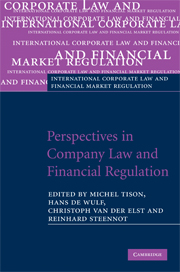Book contents
- Frontmatter
- Contents
- List of contributors
- Foreword
- PART I Perspectives in company law, SECTION 1: European company law: regulatory competition and free movement of companies
- PART 1 Perspectives in company law, SECTION 2: Corporate governance, shareholders' rights and auditing
- PART 1 Perspectives in company law, SECTION 3: Takeover law
- PART II Perspectives in financial regulation, SECTION 1: European perspectives
- 24 Principles-based, risk-based regulation and effective enforcement
- 25 The Committee of European Securities Regulators and level 3 of the Lamfalussy Process
- 26 Market transparency and best execution: bond trading under MiFID
- 27 The statutory authority of the European Central Bank and euro-area national central banks over TARGET2-Securities
- PART 2 Perspectives in financial regulation, SECTION 2: Transatlantic perspectives
- PART III Miscellaneous
- Index
- References
27 - The statutory authority of the European Central Bank and euro-area national central banks over TARGET2-Securities
from PART II - Perspectives in financial regulation, SECTION 1: European perspectives
Published online by Cambridge University Press: 04 August 2010
- Frontmatter
- Contents
- List of contributors
- Foreword
- PART I Perspectives in company law, SECTION 1: European company law: regulatory competition and free movement of companies
- PART 1 Perspectives in company law, SECTION 2: Corporate governance, shareholders' rights and auditing
- PART 1 Perspectives in company law, SECTION 3: Takeover law
- PART II Perspectives in financial regulation, SECTION 1: European perspectives
- 24 Principles-based, risk-based regulation and effective enforcement
- 25 The Committee of European Securities Regulators and level 3 of the Lamfalussy Process
- 26 Market transparency and best execution: bond trading under MiFID
- 27 The statutory authority of the European Central Bank and euro-area national central banks over TARGET2-Securities
- PART 2 Perspectives in financial regulation, SECTION 2: Transatlantic perspectives
- PART III Miscellaneous
- Index
- References
Summary
Introduction
As an academic as well as a banking and securities regulator, the dedicatee of this volume has made significant contributions to the integration of European financial markets. Accordingly, the topics of his publications reflect the ongoing integration process of European financial markets and of European securities markets, in particular. While, at the outset, his interests focused on securities regulation in Europe, he has recently turned to studying the various initiatives to render clearing and settlement in Europe more efficient. Indeed, while safe and efficient clearing and settlement systems are universally acknowledged as being an essential factor in the creation of an integrated European financial market, numerous obstacles still exist that render cross-border securities transactions costly and less efficient than ultimately possible.
TARGET2-Securities (in financial jargon ‘T2S’) is one of the most advanced steps towards a more efficient and sound clearing and settlement infrastructure for the European securities market. The project undertaken by the Eurosystem, i.e., the European System of Central Banks (ESCB) known as ‘the European Central Bank (ECB) and the national central banks (NCBs) of those Member States whose currency is the euro’, aims at creating a settlement service for securities transactions linked to the existing Europe-wide cash settlement system known as TARGET2. The project is praised as being ‘ground-breaking’ or even as an ‘opportunity to jointly shape the future’, but has also met with severe criticism, sometimes to the point of outright rejection.
- Type
- Chapter
- Information
- Perspectives in Company Law and Financial Regulation , pp. 497 - 520Publisher: Cambridge University PressPrint publication year: 2009

